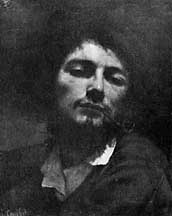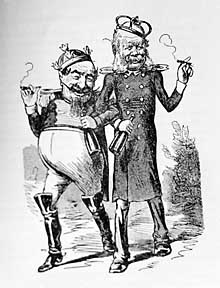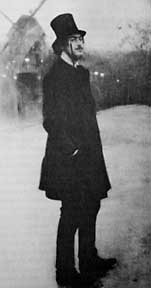 |
Gustav Corbet, Self Portrait with Pipe Bohemian artist Gustav Corbet was a leading figure in the bohemian art movement of the 1850’s. |
Current Issue Highlights More Readings DA Home About Direct Art
Evolution of the Artist
by Annabell Shark
Trying to impress someone in New York City by saying that you are an artist has become almost laughable. Being an artist in this society carries with it the connotations of irresponsibility, laziness, adolescent romanticism, parasitism, and a pervasive lack of funds. Only by showing in a well-known gallery and selling your work for sizable sums, will you rise above the social stigma the word "artist" elicits. But up until the l9th century quite the opposite was true: artists were, from prehistoric times onward, not only considered vital to society, they were once functionally the purveyors of magic powers and essential conduits of religious indoctrination. By the l500s, as European society was exploding with cataclysmic changes brought on by the Renaissance, certain artists had risen to positions of great nobility. Today’s disparagement of the artist is a modern phenomenon. Perhaps it need not be so.
In the Aristotelian fixed universe, which culminated in the Middle Ages, the artist, like everybody else on earth, had an immutable purpose to his/her life. For the artist it was to serve as a lightning rod between Divinity and the humans. Art was nothing more nor less than a representation of the World of God, and the artist, the medium through which this Universe becomes visible to mortals. In one sense, the artist was a "craftsperson", a decorator, a manufacturer, but on a higher level than a shoemaker, in societies where materialism had not yet taken control.
The Renaissance was, most fundamentally, a breaking with the Aristotelian conception of the staid universe, and a subsequent period of questioning and infinite possibility. For artists, whose place and purpose in society had been consistently of absolute importance, these changes were both marvelous and jarring.
The first part of the Renaissance found the artist within the medieval established guilds: workshops that were based on apprenticeship rather than talent. The workshops turned out paintings and sculpture under the authorship of a master, with numerous assistants who had graduated from the tasks of preparing colors and priming canvasses to executing less significant parts of the body or bits of garment. The workshops did turn out the occasional masterpiece, but they just as avidly produced shop signs, architectural décor, armor and tapestry patterns.
A new ruling class was emerging, vying for power with the entrenched nobility, whose chosen position had been held in place in no small part by medieval philosophy. The place of the nobility was neatly up there, not far from God — a position that went unchallenged for many hundreds of years. Along came the merchants, the shipbuilders and empire eradicators, and with them, a whole new philosophy that freed them up, both morally and literally, so they could plunder and grab and still go to heaven. With their sparkling new ideas of liberty, freedom and the infinite possibilities of humankind, came the ascendance of the individual. For artists, this was an extraordinary concept, and one that they proceeded to proclaim as their own.
Master artists began, by the l500s, to develop autonomy in choosing subject matter as well as style. Artists, especially in Italy where court artists were free to travel from patron to patron, instead of being confined to a guild, became the great and enormously well paid superstars of their day. It was the artist who took the recognition of the individual as unfettered genius way beyond anything previously imagined.
The great Renaissance masters that we’re familiar with today were not only recognized in their time by the royalty; they were themselves great lords. Raphael, Titian, Michelangelo, Leonardo, Filippo Lippi all amassed great wealth and power.
The first individualist / "modern" artist was Michelangelo, who dictated his own work from conception to the end, as opposed to working within the collective process, which had always been the standard form. Michelangelo was the first artist to boldly sign his work. Above and beyond the status of lord, he eschewed public honors, titles and distinctions.
He is the first example of the modern, lonely, demonically impelled artist — the first to be completely possessed by his idea and for whom nothing exists but his idea — who feels a deep sense of responsibility towards his gifts and sees a higher and superhuman power in his artistic genius. A degree of sovereignty is attained here, in the light of which all earlier conceptions of artistic freedom fade into nothingness. Now, for the first time, the full emancipation of the artist is achieved; … the patron is exalted by the very act of exalting the artist and praises the artist instead of being praised by him. Charles V stoops to recover the brush which Titian drops, and thinks nothing is more natural than a master like Titian should be waited on by an emperor.(from The Social History of Art, Vol I, Arnold Hauser, l95l)
 |
Gustav Corbet, Self Portrait with Pipe Bohemian artist Gustav Corbet was a leading figure in the bohemian art movement of the 1850’s. |
The modernity of the artistic notion has to be understood by unraveling the subtle and cataclysmic changes that took place in European society, as this civilization in general changed from a feudal structure of inflexibility and predetermination, to a bourgeois ruling order in which the overriding ethos became: WHAT WORKS IS TRUE.
Science was replacing mysticism and magic, and the artist became not so much a visionary of God as a replicator of what is real.
The French Revolution of l789 was the culmination of this struggle between the feudal world of nobility rule and the bourgeois world of rule by accumulated wealth. The catastrophic effect of this social upsurge on the artist remains with us to this day.
Like a balloon at bursting point, the French Revolution brought artists to unprecedented heights of societal power. Napoleon appointed Jacques Louis David artistic dictator of the Revolution, and his school of art, the "revolution Davidienne", developed visual art at a pace with, and in exacting relationship to, the political upheavals of the day. Art was taken away from the control of the nobility under the auspices of the Academy, which had held annual exhibitions (Salons). The Salons up until David’s reign were completely closed affairs of state. In 1791, the Salon was opened up to all artists, regardless of aristocratic connections. But the reason for this new development was not a democratization of art, but rather a very clear use of art as a vehicle for changing society. In other words, spreading art around for all to see and participate in was only a byproduct of a deeper purpose, one that recognized the intense power inherent in an image and put artists to work to create a new society.
Alas, it was the money grubbers who were now the ruling class, and this bourgeoisie was hardly interested in revolutionizing society past the point of ensuring their own status and freedom to plunder. The Salons, once grandiose exhibits of powerful epic images, became, in the words of a writer for L’Artiste of 1932, exhibitions where the artist "…gives his talent over to industry, to the caprices of fashion, to the whims of the buyers, the bourgeois." Art was, in fact, becoming interior decorating.
 |
Political Cartoon, 1870 Louis Bonaparte Napoleon III and Wilhelm l of Prussia are depicted here as drunken buffoons in this cartoon, depicting the moral and spiritual demise of the ideals fought for in the French Revolution. |
The period after the French Revolution (culminating in the numerous l848 revolutions that swept across Europe), experienced a similar phenomenon. While people were freed from the centuries-old yoke of feudalism and the absolute, unquestioned dictatorship of the nobility, the free market that the bourgeoisie laid open before society created social dissolution such as the world had heretofore never known. People were now indeed free: free to find their own method of survival; equally free to starve to death.
For artists this meant very concretely the end of patronage and the wholesale dumping of these artists into the maelstrom of the market. Art had to become "marketable" then for the artist to simply maintain a roof over his head. The art had to be small, to fit onto the parlour wall of the bourgeois home, the subject matter had to be palatable to the buyer’s world view, or, perhaps a more modern phenomenon took place: the artist became a trickster who was able to convince wealthy buyers of the commodity value of his art.
Many in the 19th century were disgusted and disillusioned with this turn of events (only in the present has this relationship between art and money become pervasively acceptable, most remarkably by the artists themselves!). What then developed from the disillusionment with bourgeois moral values and the commodification of art was a new element in society: the Bohemians — the disillusioned, disgruntled, idealistic artists and writers who insisted on maintaining their own vision, most often at the expense of physical survival. Despite their deeply felt antagonism to the bourgeoisie, Karl Marx referred to them as:
"…decayed roués with dubious means of subsistence and of dubious origin, ruined and adventurous offshoots of the bourgeoisie,…vagabonds, discharged soldiers, discharged jailbirds, escaped galley slaves, swindlers, mountebanks, lazzaroni, pickpockets, literati, organ-grinders, rag-pickers, knife grinders, tinkers, beggars, — in short, the whole indefinite, disintegrated mass, thrown hither and thither, which the French term la Boheme."
Karl Marx, The Eighteenth Brumaire of Louis Bonaparte, 1852
 |
Portrait of Erik Satie by Ramon Casas entitled, "The Bohemian" |
On occasion, one of them will be swept up by the ruling class, lauded and esteemed, but only on a rare occasion. Has this dislocation made art greater? Is its relationship to the human condition truer?
For all those who insist that suffering and alienation are the rudiments of great art, perhaps they should look back into history, and imagine the heights that could be achieved if artists were treated once again with reverence instead of scorn.
Current Issue Highlights More Readings DA Home About Direct Art